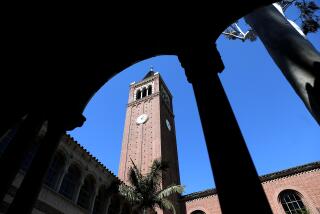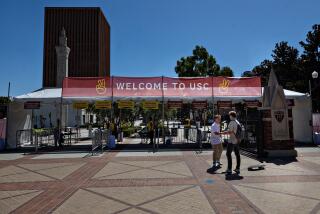Measure Will Ease Student Transfers : Schools Await Guidelines on State Residency Law
- Share via
Officials in the Beverly Hills, Culver City and Santa Monica-Malibu unified school districts plan to delay their compliance with a state law that will require districts to admit students who live outside their boundaries.
The law, which takes effect Jan. 1, amends the education code to require school districts to consider a parent’s work address a place of residence. The change will make it easier for parents who wish to transfer their children out of their home districts to schools closer to their jobs. Districts would get additional state funds based on the number of new students.
Officials in the three districts said they plan to wait to implement the law until the state issues guidelines on how they should follow it.
“You could ask any number of lawyers and get any number of different opinions on this law,” said Mark Egerman, Beverly Hills school board president. “We will have to wait until we get regulations from the state and take a hard look at the spaces available in our district and the cost of permitting students in.”
Some Exceptions
The law allows districts to exclude students whose transfers would tip the racial balance of a district, jeopardizing court-ordered or voluntary desegregation plans. Districts are also allowed to refuse a student if the cost of educating him is greater than the revenue the district would receive from the state.
The Culver City and Santa Monica-Malibu school districts have already decided to wait until September to admit students under the law. The Beverly Hills Board of Education will discuss the matter at a special meeting Tuesday. The board has already received petitions bearing the signatures of 150 parents who are opposed to the idea.
Opponents of the transfer program in Beverly Hills have argued that the district will have trouble getting a parcel tax passed in the March election to help the schools if the voters perceive that the money is being used to educate outsiders. A two-thirds vote of approval would be needed to pass the $270 annual tax on each parcel of land in the city.
The parents have won the support of some board members.
“I think it is wrong to have an influx of children whose parents will not have any voting rights here,” school board member Frank Fenton said. “I’m not willing to break up the boundaries of this district to bring in some money.”
Not Fair
Fenton said it would not be fair to “open the doors” of the district to outside students when so many parents have sacrificed to send their children to Beverly Hills schools.
“I’m not willing to open the doors to everybody who happens to work in the city when some people have paid millions of dollars for the same privileges. And on the other side, you have people who are spending from 50% to 70% of their income on rent solely for the purpose of getting their kids in our school district, and a lot of them are single parents.”
Fenton and other board members said they support the current program of allowing some students with permits to attend Beverly Hills schools, particularly those whose parents work for the city or the school district.
Assistant Supt. Walther R. Puffer said that the district’s four elementary and middle schools could absorb 250 to 350 students and bring in an additional $1 million in state revenues. But parents argue that the additional students would increase class sizes.
May Start in September
In the Santa Monica-Malibu district, the law is being viewed more favorably. School officials there said they were reluctant to begin admitting students in January, because there were no funds in the budget, but they discussed a campaign to advertise the option for September.
“We are going to begin the process of identifying people interested in taking advantage of the transfer program before the start of school by notifying employers of what is available,” said Mary Kay Kamath, president of the Santa Monica-Malibu Board of Education.
The Santa Monica-Malibu district is expected to have space for additional students. Enrollments in that district have dropped from a high of 14,000 in 1977 to 9,458 students this year. The number is projected to drop by another 200 next year.
Kamath said there will be space for the additional students because in September the district plans to reduce the size of its elementary schools by moving the sixth-graders to the middle schools or former junior high schools.
Culver City Supt. Curtis I. Rethmeyer said that his district may not have space for students from outside the district.
Though Culver City’s overall student population has declined, officials predict that the elementary schools will experience a small growth spurt and the district is considering opening a fifth school to handle the increase.
More to Read
Sign up for Essential California
The most important California stories and recommendations in your inbox every morning.
You may occasionally receive promotional content from the Los Angeles Times.










